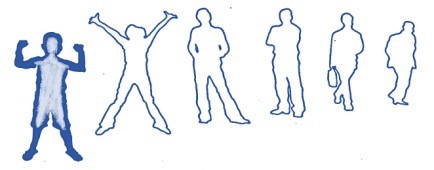I bet you all know someone in your close environment – a friend, family member, workmate - who suffers from chronic pain. Maybe chronic pain even controls your own life from time to time? Let me reassure you, you’re not the only one.
These days, many people suffer from chronic pain. Chronic back pain, neck pain, abdominal pain and headache are frequently reported. Chronic pain is a health problem accounting for high socio-economical costs; patients seek the help of numerous specialists in order to find an explanation for their ongoing pain. However, based on our current understanding, pain isn’t always a true representation of what’s wrong in our body; pain can occur without the presence of damaged body tissue(s). Fortunately, many clinicians are aware of this ‘new’ insight and are treating chronic pain patients accordingly. Physiotherapists explain pain during treatment in order to change their patients’ thoughts about pain and hereby tackling possible barriers for further treatment. No doubt that this approach will turn out beneficial in the future. However, what if we could act faster; what about educating children and their parents about pain, to prevent chronic pain from occurring?

For several years a link has been reported between childhood pain and the occurrence of pain in adulthood. Functional abdominal pain, for example, might be an early sign of vulnerability to chronic pain that becomes manifest in non-abdominal pain locations in adulthood. Unfortunately, the few studies that evaluated this potential link were not methodologically ideal. They didn’t examine the occurrence of non-abdominal pain by using a prospective design, the studies didn’t extend into adulthood and didn’t report base rates of non-abdominal pain in a comparison group of healthy adults.
Walker and colleagues were the first ones to tackle this problem. They systematically assessed chronic pain in adulthood by following a cohort of children with functional abdominal pain and healthy controls prospectively for up to 15 years. A total group of 155 children (8-16 years old) was interviewed several years later, when they had reached adulthood. Interestingly, 65% of them reported no abdominal pain symptoms and were considered ‘recovered’. At the same time, 35% of them grew up into adults with chronic abdominal pain. Interestingly, the majority of this subgroup also reported symptoms consistent with the International Headache Society’s criteria for migraine and/or tension-type headache. Besides, they were more likely to report current chronic pain (defined as 3 months or more of daily or nearly daily pain) in the pelvis, back, shoulder, and upper and lower limbs. Thus, it appeared that this ‘unrecovered’ subgroup of children with functional abdominal pain matured into adults with functional gastrointestinal disorders, comorbid chronic pain and/or headache. Is it within our power to identify this subgroup and prevent this pain from occurring?
The link between childhood pain and chronic pain in adulthood is complex. Research is needed to reveal every piece of this multifactorial puzzle. Functional abdominal pain in children possibly represents a centrally mediated augmentation of pain and sensory processes that can be manifest in both visceral and somatic pain conditions. Indeed, central sensitization, defined as an elevated responsiveness to nociceptive stimuli resulting from increased excitability of neurons in the dorsal horn of the spinal cord, is likely to occur in children with chronic abdominal pain.
Adults with chronic pain are currently treated by using a modern neuroscience approach (including pain education) and we know all about its positive effects. Why shouldn’t we try to do to the same with children? There’s nothing to lose!
Roselien Pas
PhD researcher at Vrije Universiteit Brussel, Brussels, Belgium
Funded by VUB Chair ‘The Berekuyl Academy’
2017 Pain in Motion
References and further reading:
Walker LS, Dengler-crish CM, Rippel S, Bruehl S. Functional abdominal pain in childhood and adolescence increases risk for chronic pain in adulthood. Pain. 2010;150:568–72.
https://www.ncbi.nlm.nih.gov/pubmed/20615615
Malfliet A, Leysen L, Pas R, Kuppens K, Nijs J, Van Wilgen P, Huysmans E, Goudman L, Ickmans K. Modern pain neuroscience in clinical practice: applied to post-cancer, paediatric and sports-related pain. Braz J Phys Ther. 2017 Jul - Aug;21(4):225-232.
https://www.ncbi.nlm.nih.gov/pubmed/28579013
Morris MC, Walker LS, Bruehl S, Stone AL, Mielock AS, Rao U. Impaired conditioned pain modulation in youth with functional abdominal pain. Pain. 2016 Oct;157(10):2375-81.
https://www.ncbi.nlm.nih.gov/pubmed/27389918
Duarte M a, Goulart EM, Penna FJ. Pressure pain threshold in children with recurrent abdominal pain. J Pediatr Gastroenterol Nutr. 2000;31:280–5.
https://www.ncbi.nlm.nih.gov/pubmed/10997373
Hermann C, Zohsel K, Hohmeister J, Flor H. Cortical correlates of an attentional bias to painful and innocuous somatic stimuli in children with recurrent abdominal pain. Pain. 2008;136:397–406.
https://www.ncbi.nlm.nih.gov/pubmed/18276076
Williams AE, Heitkemper M, Self MM, Czyzewski DI, Shulman RJ. Endogenous inhibition of somatic pain is impaired in girls with irritable bowel syndrome compared with healthy girls. J Pain. 2013;14:921–30.